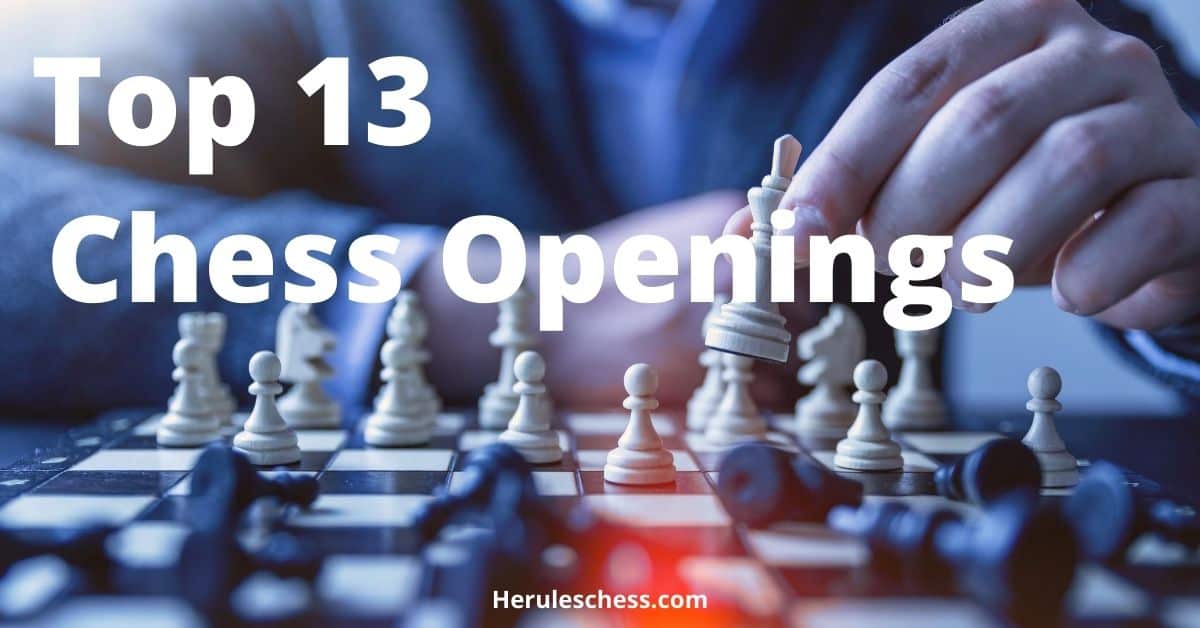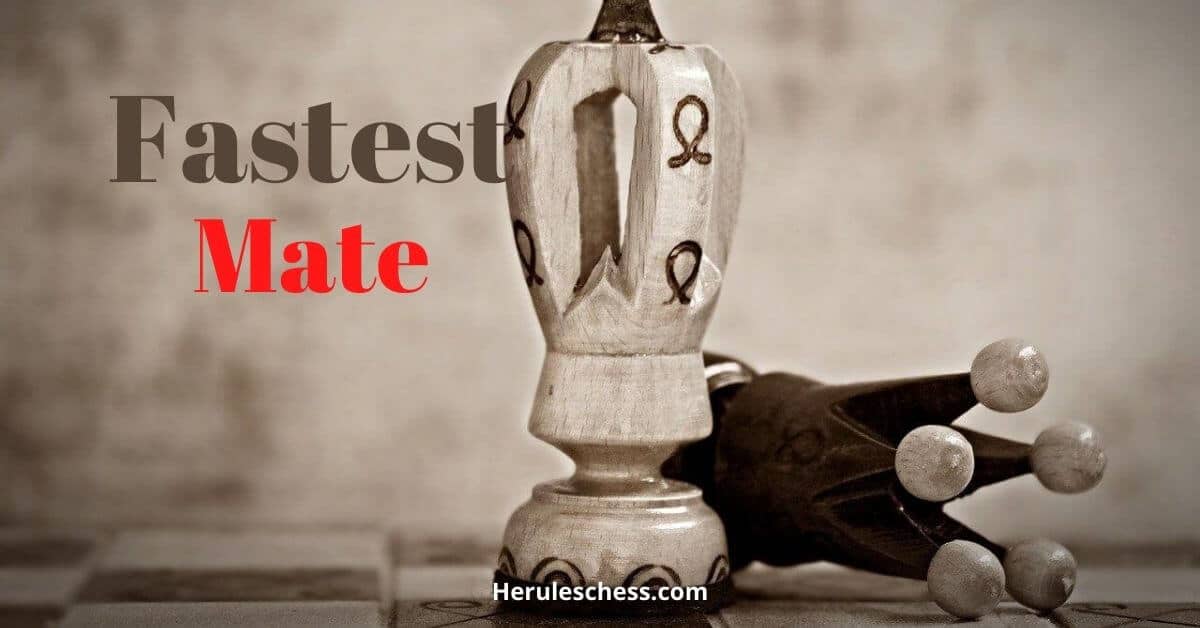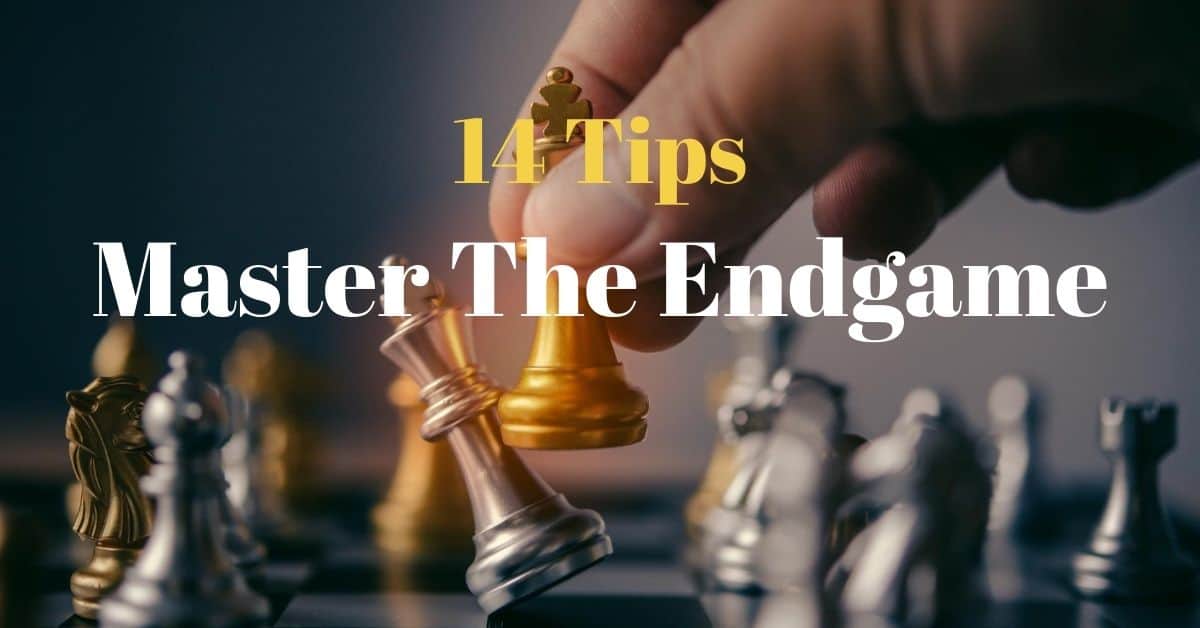When you first start playing chess you will sometimes hear other people say that the Rooks are also called Castles. Although they look like castles, more experienced players will always call them Rooks. Rooks are very valuable in a game of chess, so they are referred to as major pieces. They resemble castle turrets which is why they are sometimes called Castles.
How Does The Rook Move
So how does the rook move in chess? Rooks move in straight lines, up and down the files or side to side across the ranks. They can move as many squares as they want to in a straight line.
Sadly, Rooks can never jump over any other pieces like the Knight, so if an enemy soldier is in their way, they must either stop or capture it.
Rook moving vertically and horizontally
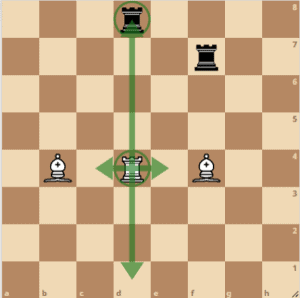
This white Rook can move straight up the board and capture the black Rook on d8. Rooks are considered to be powerful pieces, especially when it comes to protecting and working with each other to attack the opponent. Captures in a chess game are optional. The rook does not necessarily have to make any capture. It is allowed to capture other pieces only if you want it to.
Castling with Rook
Castling is a special move that involves the Rook and King. Castling allows you to:
- Protect your King from threats
- Develop and coordinate your Rooks
Castling works by moving the king two squares to one side and then shifting the rook right next to the king on the opposite side. However, to be able to castle with rook and king, the following conditions must be met:
- For the rook, it must be the first move
- For the king, it must be the first move
- The path between the king and rook must be clear (no pieces can block them)
- The king cannot be under “check,” or must not have passed one
There are two types of castling:
- Kingside castle: Castling on the side of the board where the king is closest to
- Queenside castle: Castling on the side of the board where the queen is closest to
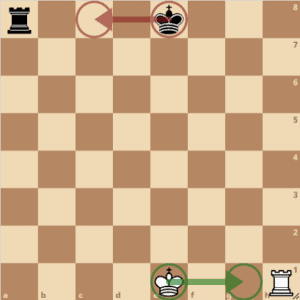
Related Post: How do all the chess pieces move?
Rooks on the Seventh Rank
Rooks are usually glad when pawns and pieces get traded. That’s because the rook grows stronger as the position becomes more open. The favorite place for a rook to be is on the seventh rank.
That means the seventh row from your own side of the board. For a black rook, it is rank number 2. A “rook on the seventh” rank can do two things:
- Attack unmoved pawns from the side.
- Trap the king on the back row.
Sometimes it’s worth sacking a pawn to get the rook on the seventh rank. In this position, black is up a pawn but white just played the powerful 1.Rd7!
Rooks on the seventh rank
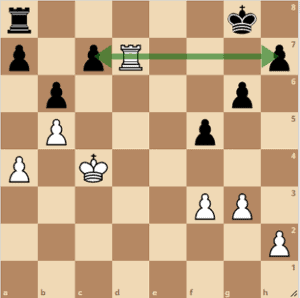
The white rook cuts the black king off along the last rank. Now the king can’t come out to play. The black pawns at c7 and h7 are also attacked. Because pawns can only go forward, they can’t defend themselves very well from one side. Black will have to use pieces to protect them. White has a winning advantage.
To save the pawn on c7, black has to defend it with the rook. Playing 1…c5 looks like a good idea. But white could take it with en passant (2.bxc6 e.p)
1…Rc8 2.Kd5
Now that the black pieces are stuck on guard duty, white plans to walk his king up and start winning pawns. Black has no good way to counter this plan.
2…h6 3.Kc6 Kf8 4.Rxc7 Rxc7+ 5.Kxc7 1-0 The pawn endgame is losing for black because the white king is better placed. (5…Ke7 6.Kb7 Kd6 7.Kxa7.)
The ultimate fun for rooks is when they both get on the seventh rank! First, let’s look at how double rooks on the seventh rank can lead to checkmate.
Scenario 1: In this diagram, black to play has a typical mate in 3
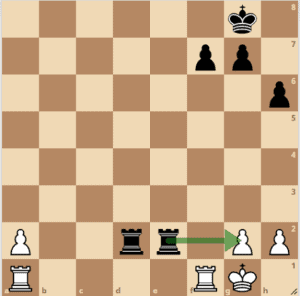
1…Rxg2+ 2.Kh1 Rxh2+ 3.Kg1 Rdg2#
Scenario 2: Black to play has mate in 2
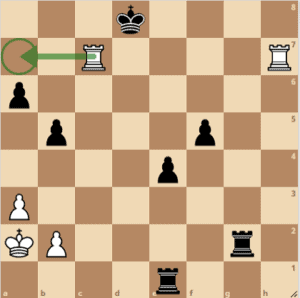
1.Ra7! 0-1
Besides winning games for you, the doubled rooks can also save you from defeat. The standard drawing method is by perpetual check. In the example below, black is the one ready to give checkmate. [From mobile click the icon at the bottom right to view the game]
But white can escape with a draw by checking for dear life. 1.Rg7+ Kh8 2.Rxh7+ Kg8 3.Rxh7+! Note that checking at any time with the rook on e7 loses. After the black king reached d8, the checks are over, and not ( 3.Rxh3+? Qc6+! 4.Kg2 Qc5+)
3…Kh8 4.Rh7+ Kg8 5.Rh7+ ½–½
Rook Lifts
Rook lifts are a great way to develop your rooks. Rooks are tough, but not at the start of the game They’re stuck in the corners then, with no easy road out. We usually develop rooks by moving them to files that are not blocked by pawns. Those are called open files. Another way to get your rook into action is with a rook lift. As you might already know, a lift is the British term for an elevator.
Here is what happens in a “rook lift”:
The pawn in front of a rook moves two squares and then the rook goes up to the third rank. It’s just like taking the elevator up to the third floor! From there, the rook moves along the rank to find a good spot for attacking.
In this diagram, the black king is in trouble. If white can get a rook to the kingside, it will be game over. Too bad the Bishop on a6 stops 1.Rd3. The natural move for white is 1.Re1, switching the rook to the open e-file. But then black counters with 1…Re8. So white uses the other rook instead. All it takes is an elevator ride!
1.a4!
There is no good defense to the rook lift. After 2.Ra3, it’s going to be the old crash and crush with Rg3 or Rh3. Black brings the bishop over to try and shield the king.
1…Bc8 2.Ra3 Bf5!? 3.Rg3+ Bg6 4.Rxg6+!
The rook isn’t about to let a bishop get in the way. The sacrifice leaves the black king wide open (4.Rh3 Qf6) 4…fxg6 5.Qxg6+ Kh8 6.Qh5+ Kg7 7.Rd3! Another lift for the final assault! 7…Rh8 8.Rg3+ Kf6. and white mates in 3!
This last example is a real blast-o-rama! The black king only has a few loyal pawns to guard him. They wont be a match for the aggressive white pieces. There are several ways for white to break through here 1.Qh5 and 1.Bxg7 are both powerful moves.
White chooses to sacrifice their bishop with a check. In this line, white doesn’t have to push a pawn first to prepare the rook lift. The fireworks begin with 1.Bxh7+ Kxh7 2.Qh5+ Kg8 Now comes the second explosion 3.Bxg7!
Kaboom! White threatens 4.Qh8#
3…Kxg7 Without his pawns, the black king is a sitting duck for the white queen and rooks. 4.Qg5+ Kh7 5.Rf3! 1-0. The rook takes a lift to the third rank. Mate by 6.Rh3+ is unstoppable.
Rooks and Passed Pawns
Rooks are often the last pieces to be traded. So being good at rook endings is aver useful skill. The first rule in rook endgames is to keep your rook active. The surest way to get a bad game is to place your rook in a passive position where it is stuck defending a pawn.
When there is a passed pawn on the board, both players should try to out their rook behind the pawn. Then every time the pawn goes forward the rook will get more room to move. If the rook stands in front of the pawn, then the opposite happens. With each step of the pawn, the freedom of the rook will decrease.
Frequently Asked Questions
Can Rooks move backward?
The rook can move backwards in a straight line as many squares as possible so long as it is not obstructed. It can move vertically and horizontally across the board.
Can a Rook move diagonally?
Since the Rook moves up and down, left or right, it cannot move diagonally like the Bishops. The only pieces that can move diagonally are the Bishops, Queen, King, and sometimes pawn when they en passant.
Why can’t I move my Rook in the starting position?
Since the pawns obstruct the Rook in the starting position of a chess game, it cannot jump over its own pawns nor move at all unless you free the wing pawns on the flank. The Rooks usually become active after castling.
Related Post: How does the queen move




